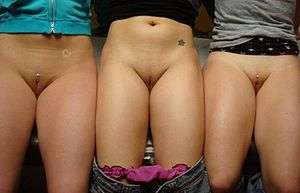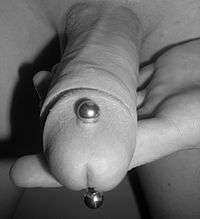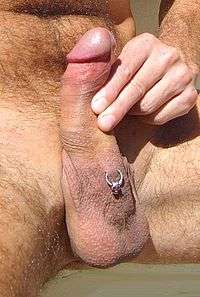Genital piercing


Genital piercing is a form of body piercing that involves piercing a part of the genitalia, thus creating a suitable place for wearing different types of jewellery. Nevertheless, the term may also be used pars pro toto to indicate all body piercings in the area of anus, perineum, genitals and mons pubis, including piercings such as anal, guiche, and pubic that do not involve perforation of genitalia. Genital piercings can be done in men or women, with various forms of piercings available. The main motive for both genders is beautification and individualization, in addition some piercings enhance sexual pleasure by increasing stimulation.[1][2][3] Genital piercings can be found in many tribal societies, in particular in South and East Asia, where it has been part of traditional practice since ancient times. Early records of genital piercing are found in the Kama Sutra that was written over 2000 years ago. It first appeared in western societies in the 1970s in Southern California, yet confined to an alternative subcultural context. Only with the beginning of the 21st century it gained wider popularity in modern society.
History
The traditional heritage place of genital piercings is assumed to be South East Asia, with traditional piercings being found in tribes ranging from India to Borneo. Piercings of the genitals have a long tradition, with sources mentioning the Apadravya, a male genital piercing, as early as in the Kama Sutra (second century).[4]
The ampallang, a similar piercing (which passes horizontally through the glans instead of vertically), is found in different tribes throughout Sarawak and Sabah on the island of Borneo. Genital piercings became first introduced in western countries by ethnographic report, done by explorers such as in the 19th century. The Dutch explorer Anton Willem Nieuwenhuis described in his ethnographic record In Centraal Borneo: reis van Pontianak naar Samarinda - documenting his travel through Borneo in 1897 - the procedure of an ampallang piercing:
″The young men through the tattoo, because it is performed by them only to a limited extent, much less than women to suffer for it but they must in order to gain their full manhood, subject of another test, namely the through-hole the glans penis. This operation procedure is as follows: First, the glans made anemic by pressing between the two arms of a folded over strip of bamboo. At each of these arms are opposite each other where needed openings through which one after the round pressed glans become less sensitive to an acute kapfernen pin; formerly was used for this purpose a pointed bamboo sticks. The bamboo and the clamp is removed by means of a cord attached to pin left in the opening until the channel is healed. Later, the copper pin (utang) by another, usually through a tin, replaced, which is worn at all times, making only heavy work or strenuous operations of the metal pin a wooden square. Particularly brave men enjoy with the chief's prerogative to be allowed to wear the penis a ring in the scales of the pangolin cut and blunt teeth is occupied; sometimes they can also be crossed with the first channel, a second by the glans . Drill In addition to the Kayan themselves, engage in many Malays from the upper Kapuas this art. The pain during surgery do not seem to be very violent, and it has only rarely serious consequences, although until recovery can often take a month.″[5] - Anton Willem Nieuwenhuis
Piercing the genitals became a short-lived trend at the end of the 19th century, in particular for upper classes of the society:
″[...] it was during the Victorian era that the practice of body piercing in the Western world reemerged. Many men and women of the Victorian royalty chose to receive nipple and genital piercings.″[6]


However, the popularity diminished again, with genital piercings becoming rather uncommon in the western world until the second half of the 20th century. In the 1970s, they were introduced to the emerging body modification community by the early piercings pioneers like Jim Ward and Doug Malloy, many of them associated with the legandary piercing studio The Gauntlet in Los Angeles. With the advent of Piercing Fans International Quarterly in 1977, information about genital piercings became available to a wider community. Genital piercings were later sported by the modern primitives movement that developed during the 1980s in the San Francisco Bay Area. Still, only until the 21st century, genital piercing was confined to a body modification subculture.
Just like nipple piercings[9], genital piercings became increasingly more popular and part of mainstream culture in the second decade of the 21st century, with ″nice and normal″ people endorsing them.[10] Statistically, people that nowadays get genital piercings in the United States are predominantly caucasian, of younger age and better educated than the average American.[11] Many celebrities such as Christina Aguilera[12], Fantasia Barrino[13], Pete Doherty[14], Lady Gaga[15], Janet Jackson,[16], Lenny Kravitz,[17], Katarina Waters,[18] or Pete Wentz,[15] stated to have or planned to have genital piercings. Genital piercings nowadays have a growing demand, especially in a young adult, college-aged population.[19][20][21]
With regard to (female) genital piercings, Marilyn W. Edmunds - adjunct clinical professor at the Johns Hopkins University - states that:
″Women with genital piercings are no longer on the social fringe or part of the "punk" culture who are experimenting with behaviors that are "socially provocative." Over the past 30 years, genital piercing has become mainstream, and women engage in it for a variety of reasons.″[22]
However, according to Chelsea Bunz, professional piercer from UK, the clearly existing rise in popularity might as well be an effect of more people openly talking about their genital piercings:
″I think genital piercing has always been popular – it’s just discussed more openly these days, which makes it increasingly acceptable to the mainstream. People from all classes and professions have them (...)″[23]
Motives
Like body piercings at large, genital piercings are often done for aesthetic reasons and as an expression of personal style. In addition, some (but not all) types of genital piercing increase sensitivity and provide additional stimulation during sexual intercourse or stimulation. According to an Association of Professional Piercers expert report by Elayne Angel, body piercing pioneer, former member of The Gauntlet and inventor of several genital piercings such as the fourchette and the lorum, individual motivs and preferences are quite diverse:

"Many adults are interested in genital piercing but aren’t really sure which of the many options to select. They want to know which isthe “best piercing” but there is no “one-piercing-fits-all” answer. It depends on many factors and highly individual desires and preferences(without even bringing individual anatomy in to the discussion yet). For some clients the most important aspect is that the piercing pleases their partner. Others have the priority of increasing their own sensation in a particular area or manner. Some want the one that will show the most, others to heal the fastest, yet others want one that is least likely to bleed! And on it goes. You will need to interview each client to determine the specific motivations and expectations for genital piercings. Inquire about which piercing(s) are of interest—and why? Is stimulation or aesthetics a primary motivation? Is the stimulation important more for the piercee, or does the piercee desire that sensation more forhis/her partner? Then there are deeper specifics to probe (pardon the expression) such as whether the goal is increased sensation during penetration, or enhanced clitoral stimulation.[...]″[24] - Elayne Angel
Aesthetic reasons
Motivation can be restricted purely to aesthetic taste. Like all other types of body piercing, genital piercings are decorative, appealing to the people wearing them:
″For me personally, it was sheer aesthetics – I just like how it looks. Even if I was the only person who ever saw my piercing, I’d like it in the same way that I like having painted toenails – something pretty for my own personal pleasure.″[23] - Violet Fenn
Culture and life style
In many traditional cultures, these piercings are done as a rite of passage during adolescence and, symbolically and literally, mark the admittance to the adult world and serve as a marker of cultural identity. Similar to religiously motivated circumcision, it may be regard as a "purification of the flesh" and a common bodily sign to members of the same faith. These traditional meanings of modifing the body were revived in contemporary western society by the Modern primitive. Inspired by ethnographic accounts of tribal practices, this subculture adopted genital piercings as a matter individuation and spirituality.[25]
However, for most people that seek genital piercings nowaday, a sense of uniqueness and non-conformism prevails:
″My VCH piercing is one of my favorite things about myself. I felt like a freaky little celebrity walking around with my secret piercing. It makes me feel unique, badass and sexy.″[26] - Ray Gallagher
Pleasure and sensation
Additionally, genital piercings can enhance sexual pleasure during masturbation, foreplay and intercourse. While female genital piercings do this only to the women wearing them, male genital piercings can enhance stimulation for both the person wearing the jewelry and their partner by stimulating both the glans of the wearer and the vaginal wall or the anus of the penetrated partner. Due to genital physiology, women seem to gain more sexual pleasure from both, their own as well as her partners genital piercings:
"The truth is that a woman will almost always be more physically stimulated than a male partner by both her genital piercings and his. There are female genital piercings that are more aesthetic than stimulating, like Christina Piercings, but clitoral hood piercings and other piercings in the clitoral area can be very stimulating during foreplay and intercourse. Add a bit of magical friction against the G-spot from a male partner’s reverse PA piercing or an apadravya, and a woman can have some of the best sex of her life."[27]
Enhanced stimulation for the sexual partner
This effect is in particular reported for piercings passing through the glans penis: the ampallang and apadravya piercing. Women of the Dayak in Sarawak, Borneo prefer men with an ampallang, claiming that intercourse without would be dull:

″The Dayak women have a right to insist upon the ampallang and if the man does not consent they may seek separation. They say that the embrace without this contrivance is plain rice; with it is rice with salt."[28]
On another account by the anthropologist Tom Harrisson, who spent much of his life in Borneo and interviewed natives about the traditional ampallang:
"[...] the function of this device is, superficially,to add to the sexual pleasure of the women by stimulating and extending the inner walls of the vagina. It is, in this, in my experience, decidedly successful."[29]
Enhanced stimulation for the pierced person
For men, piercings that stimulate the sensitive urethra, either during masturbation or sexual intercourse, increase sensation.[2] Female genital piercings that are reported to enhance pleasure are the piercings that pass through or close to the clitoris, i.e. the clitoris piercing and the clitoral hood piercing.[1] In an empirical study at the University of South Alabama, the authors reported a positive relationship between vertical clitoral hood piercings and desire, frequency of intercourse and sexual arousal.[30] However, this might depend on many factors such as placement jewelry and the individual. The triangle piercing is known to be quite pleasurable by providing stimulation of the underside of the clitoral glans, an area that is usually not stimulated at all.[31]
Legal considerations
Laws in other countries vary. In many European countries, minors are required to bring a signed consent form from or to be escorted by a legal guardian. Even in countries that have no laws regulating genital piercing in minors, many piercers refrain from doing them (since physiological development is not completed in minors). In the United States, it is prohibited to pierce the genitals of persons younger than 18 years.
Potential health risks
Comparable to other piercings, improper hygiene during the piercings process carries the risk of transmitting blood borne diseases and during the healing process it might lead to infection.
Some physicians believe that male genital piercings increase the risk of STD transmission by making safer sex barriers (condoms) less effective.[32][33] [34] Most professional piercers and body art enthusiasts believe these risks are over-stated or non existent. In two surveys, 5%-18% of men with genital piercings reported unspecified "problems using condoms" though it is unclear how many of these men used condoms regularly. [35] There is no conclusive evidence that wearers of genital piercings are more likely to contract sexually transmitted infections. [36]
Aftercare
The time to fully heal a genital piercing varies tremendously, depending on piercing site and individual characteristics: it can range from a week up to six month. Until fully healed, preparations should be made against possible causes of infection, such as proper cleaning on a daily basis. People with fresh piercings should abstain from sexual activity for the first days and also then should use physical protection barriers such as condoms until the piercing is fully healed.
Types of genital piercings
Male genital piercings
Possible piercing sites on the male genitalia include the glans, the skin of the penis shaft, the scrotum or the perineum.
Glans penis
Piercings through the glans of the penis include the ampallang, which passes horizontally, and the apadravya, that passes vertically through the glans. The Prince Albert piercing is situated on the dorsal side while the reverse Prince Albert piercing passes through the ventral side of the glans. The dydoe pierces through the coronal rim of the glans. With the exception of the dydoe, all these piercings traditionally pass through the urethra. This is preferred because the healing time, and incidence of infection is reduced by the flow of sterile urine.[37]
These piercings provide increased stimulation during intercourse to the male (who is carrying the piercing) as well as to the partner. Piercings through the head, or the glans, are the genital piercings with the best-documented historical evidence.[38]
Skin of the penis shaft and scrotum
Foreskin piercing passes through the penile prepuce on the dorsal, ventral or lateral side. It can only be applied if the male is not circumcised. The frenum piercing passes through the penile frenum, a small skin bridge that connects the glans with the shaft skin. This anatomical part is also often missing in circumcised men. The hafada piercing is situated on the skin of the scrotum. As an intermediate version between frenulum and hafada, the lorum piercing (low frenum) sits at the point where penis and scrotum connect. The Jacob's Ladder is a ladder from frenum to scrotum. The guiche piercing is a body piercing on the perineum. These piercings play a lesser role in adding stimulation and more or less fulfill only a decorative purpose.
Female genital piercings
In female individuals as well, various anatomical parts can be suitable for piercings. These include the mons pubis, the clitoris (including the clitoral hood), the (inner and outer) labia and the vulval vestibule (which is the area surrounding the vaginal opening).
Clitoris and clitoral hood
The glans of the clitoris itself can be pierced. Since this anatomical part is too small in many cases, this piercing is not very common. In contrast, the clitoral hood piercing is the most common genital piercing for female bodied individuals. It can be applied horizontally and vertically. The deep hood piercing is a variation of the clitoral hood piercing that pass deeper through the clitoral hood. The Isabella piercing passes vertically through the clitoral shaft and is rather complicated to pierce.
- Vertical clitoral hood piercing (VCH)
 Horizontal clitoral hood piercing (HCH)
Horizontal clitoral hood piercing (HCH) Deep hood piercing
Deep hood piercing
Labia and vulval vestibule
The Labia piercing can be applied at the labia majora or the labia minora. The Triangle piercing is located at the ventral end of the labia minora, at the point of transition between labia and clitoral hood. It runs horizontally, partly under the clitoral shaft. Through the dorsal rim of the vulval vestibule passes the Fourchette piercing. A less common version of the Fourchette is the Suitcase piercing, which can be considered as a deep Fourchette (it enters on the perineum). Also rather uncommon is the Princess Albertina piercing, the female version of the Prince Albert piercing, that passes through the dorsal wall of the urethra.
 Inner labia piercing
Inner labia piercing Outer labia piercing
Outer labia piercing

 Clit hood and labia piercing
Clit hood and labia piercing
Mons pubis
The Christina piercing is a surface piercing, situated on the lower part of the mons pubis where the outer labia meet. It is similar to the Nefertiti piercing, that can be seen as a combination between vertical clitoral hood piercing and Christina piercing.
Unisex
Body piercings that do not involve perforation of genitalia but referred to as "genital piercings" by convention can be worn by both genders. These include the pubic piercing, which is situated above the penis in men and on the mons pubic in women (comparable to the Christina piercing, but horizontally). The guiche piercing passes horizontally through the perineum while the anal piercing passes through the anus.
See also
External links
| Wikimedia Commons has media related to Genital piercings. |
General information
- Elayne Angel: An approach to genital piercings. published by the Association of Professional Piercers:
- General issues
- Clitoral hood and labia piercings
- Prince Albert and pubic piercings
- Frenum, Lorum, Hafada and Guiche
- Foreskin, Dydoe, Ampallang and Apadravya
Instructional step-by-step piercing procedures
- female:
- male:
Research studies
- Anderson, W.R.; Summerton, D.J.; Sharma, D.M.; Holmes, S.A. (2003). "The urologist's guide to genital piercing". BJU International. 91 (3): 245–251. ISSN 1464-4096. doi:10.1046/j.1464-410X.2003.04049.x.
- Bone, A.; Ncube, F.; Nichols, T.; Noah, N. D (2008). "Body piercing in England: a survey of piercing at sites other than earlobe". BMJ. 336 (7658): 1426–1428. ISSN 0959-8138. JSTOR 20510103. PMC 2432173
 . PMID 18556275. doi:10.1136/bmj.39580.497176.25.
. PMID 18556275. doi:10.1136/bmj.39580.497176.25. - Esen, U. I (2008). "Health and regulation issues for body piercing". BMJ. 337 (jul08 2): a595–a595. ISSN 0959-8138. JSTOR 20510253. doi:10.1136/bmj.a595.
- Johnsdotter, Sara; Essén, Birgitta (2010). "Genitals and ethnicity: the politics of genital modifications". Reproductive Health Matters. 18 (35): 29–37. ISSN 0968-8080. JSTOR 25767326. PMID 20541081. doi:10.1016/S0968-8080(10)35495-4.
- Myers, J. (1992). "NONMAINSTREAM BODY MODIFICATION: Genital Piercing, Branding, Burning, and Cutting". Journal of Contemporary Ethnography. 21 (3): 267–306. ISSN 0891-2416. doi:10.1177/089124192021003001.
- Ferguson, Henry (1999). "Body Piercing". British Medical Journal. 319 (7225): 1627–1629. JSTOR 25186687. doi:10.1136/bmj.319.7225.1627.
- Aubrey, Karen (April 1995). "Body Piercing: Gender Nihilism in the 90s". Studies in Popular Culture. Popular Culture Association in the South. 17 (2): 31–37. JSTOR 23413700.
References
- 1 2 Does A Clit Piercing Lead To Better Orgasms? 10 Things You Need To Know About Piercing Your Vagina - Bustle
- 1 2 Hogan; Rinard, K.; Young, C.; Roberts, A.; Armstrong, M.; Nelius, T. (2010). "A cross-sectional study of men with genital piercings" (PDF). British Journal of Medical Practitioners. 3 (2): 315–322.
- ↑ Van der Meer, G.; Schultz, W. W.; et al. (2008). "Intimate body piercings in women". Journal of Psychosomatic Obstetrics & Gynecology. 29 (4): 235–239. doi:10.1080/01674820802621874.
- ↑ The Apadravya In The Kama Sutra
- ↑ body-modification.com
- ↑ Larkin, B. G. (2004). "The ins and outs of body piercing". AORN journal. 79 (2): 330–342. doi:10.1016/S0001-2092(06)60609-1.
- ↑ Kasten, E. (2007). Genitale Body-Modifications bei Frauen. Der Gynäkologe, 40(6), 489-500.
- ↑ Intimmodifikationen bei Jugendlichen
- ↑ Free the Nipple Ring! Why One Vogue Writer Got Pierced - Vogue
- ↑ Nice, Normal Girls Don't Get Their Genitals Pierced - Vice Magazine
- ↑ Caliendo, C.; Armstrong, M.L.; et al. (2005). "Self-reported characteristics of women and men with intimate body piercings". J Adv Nurs. 49 (5): 474–484. doi:10.1111/j.1365-2648.2004.03320.x.
- ↑ Female body piercing
- ↑ Fantasia’s Pierced Down There - Socialite Life
- ↑ Pete Doherty's penis piercing - Female First
- 1 2 naij.com
- ↑ Janet Jackson’s Interview With Vibe Vixen
- ↑ Lenny Kravitz’s Penis Piercer Is Proud to See Her Work ‘Still Alive and Kicking’#Penisgate lives on
- ↑ Piercing genital de Karina Bacchi na Playboy causa polêmica
- ↑ Kasten, E. (2007). "Genitale Body-Modifications bei Frauen.". Der Gynäkologe. 40 (6): 489–500. doi:10.1007/s00129-007-1985-8.
- ↑ Genital piercing increasing among Kumasi youth - Ghanaweb
- ↑ VCH Piercings, by Elayne Angel, pp. 16-17, The Official Newsletter of The Association of Professional Piercers
- ↑ Why Women Choose Genital Piercing - Medscape
- 1 2 Genital piercings aren’t as scary as you think – here’s what to expect from them - Metro
- ↑ The Point, Issue 38, p.4-6
- ↑ Lane, D. C. (2017). Understanding body modification: A process‐based framework. Sociology Compass, 11(7)
- ↑ What It's Like To Get Your Clitoral Hood Pierced - Bustle
- ↑ http://info.painfulpleasures.com/help-center/information-center/basics-male-female-genital-piercings
- ↑ Mantegazza, P. (1935). The Sexual Relations of Mankind, trans. Victor Robinson. New York: Eugenics Pub. Co.
- ↑ Rowanchilde, R. (1996). Male genital modification. Human Nature, 7(2), 189-215.
- ↑ Vaughn S. Millner et al.: First glimpse of the functional benefits of clitoral hood piercings. In: American Journal of Obstetrics and Gynecology. Band 193, Nr. 3, S. 675–676.
- ↑ Can selfish lovers ever give as good as they get? - MSNBC
- ↑ Stirn, Aglaja. "Body piercing: medical consequences and psychological motivations." The Lancet 361.9364 (2003): 1205-1215.
- ↑ Gokhale, M. Hernon, and A. Ghosh. Genital piercing and sexually transmitted infections. Sex Transm Infect. 2001, 77(5): 393–394.
- ↑ Sarbu, Maria Isabela, et al. "Genital Male Piercings." Journal of Mind and Medical Sciences 2.1 (2015): 9-17.
- ↑ Nelius, Thomas, et al. "Genital piercings: Diagnostic and therapeutic implications for Urologists." Urology 78.5 (2011): 998-1007.
- ↑ ibid
- ↑ http://www.intimatemedicine.com/sex-in-society/introduction-to-male-genital-piercings/
- ↑ The Point - An Approach to Genital Piercings Part 5













